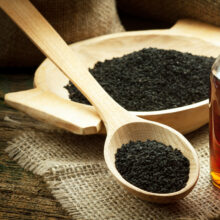Superfood: The Amazing, Alluring Fig
- Published: Thursday, July 6th 2017
- in Nutrition

Tasty and beautiful, figs are the unsung superheroes of fruits. A superfood, rich in fiber, potassium, and manganese, a single fig has only about 50 calories and to the joy of veggies, they are also a source of calcium.
Adam & Eve Were on to Something
It’s common knowledge that Adam and Eve were wearing fig leaves when they were living in the Garden of Eden. Based on remnants discovered by archeologists, figs have been consumed and used in traditional medicine for centuries. (Think 5,000 B.C.)
Today we have experts to tell us why figs are good for us. New York Times bestselling author Dr. Joseph Mercola notes that the ingredients in figs help, “…protect the heart, regulate kidney and liver functions, lower blood pressure, lower incidences of macular degeneration, and inhibit some cancers, specifically postmenopausal breast cancer.”[1] Dr. Mercola also points out that in some parts of the world, fig leaves are used in cuisine and to regulate blood sugar levels.
Fig-alicious & Packed with Nutrients
Figs have a higher mineral and fiber content than most fruits, nuts or vegetables. Just one serving contains six percent of the RDA for calcium and iron, seven percent of potassium and 20 percent of fiber.[2]
- Figs contain pectin, which can soak up cholesterol and be eliminated from the body. And they are packed with fiber, which nutritionists say can help prevent some kinds of cancers. Fiber makes you feel full and is also helpful if you want to lose weight. Plus they promote healthy bowel movements and prevent constipation.
- Dried figs contain phenol, Omega-3 and Omega-6, fatty acids that are said to reduce the risk of heart disease. Fig leaves inhibit triglycerides, another factor in heart disease.
- The American Diabetes Association recommends fresh or dried figs to help control diabetes, and fig leaves can reduce the amount of insulin needed by diabetic patients.
- As well as being high in potassium, figs are low in sodium; experts say this can help prevent hypertension.
- Fig leaves are used in a tea that eases respiratory conditions like bronchitis, and to prevent and lessen symptoms of asthma and sore throats.
- Because they have high levels of calcium, figs are said to reduce the risk of developing osteoporosis. They also contain phosphorus, which helps bones regrow.
One caution: We can’t get enough of figs but unfortunately you can eat too much of this addictively sweet superfood. Figs have a laxative effect and you shouldn’t consume excessive amounts–especially if they are dried.[3]
Is Organic Worth the Money?
Figs don’t show up on EWG’s list of the fruits and veggies with the most pesticides, which is based on data from the U.S. Department of Agriculture and Food and Drug Administration. But there are many benefits to buying organic.
How to Enjoy
A serving of figs, contains seven teaspoons of natural sugar and make a great substitute for processed sugar in desserts, smoothies, energy bars–plus they are delicious as a topping for oatmeal or raw or dried in a nutrition-filled snack.[4]
This recipe for Grilled Figs with Creamy Honeyed Ricotta and Almonds from the chefs at the award-winning Rancho LaPuerta Spa & Resort, is a delicious appetizer or served on fresh greens for a scrumptious salad.
[1] Foodfacts.mercola.con, “What Are Figs Good For?”
[2] OrganicFacts.net
[3] Honest.com, “July’s Superfood: Figs,” July 2016
[4] Onegreenplanet.org, “Health Benefits of Dried Figs, 2016



